2022年中考英语句子成分复习课件(35张PPT无素材)
文档属性
| 名称 | 2022年中考英语句子成分复习课件(35张PPT无素材) | 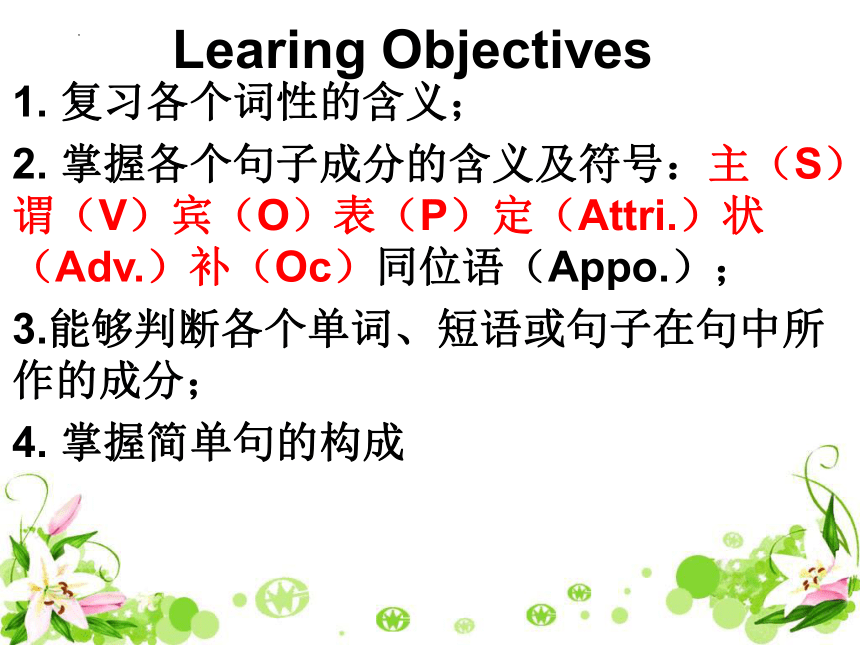 | |
| 格式 | pptx | ||
| 文件大小 | 1.1MB | ||
| 资源类型 | 教案 | ||
| 版本资源 | 通用版 | ||
| 科目 | 英语 | ||
| 更新时间 | 2022-04-10 00:03:06 | ||
图片预览

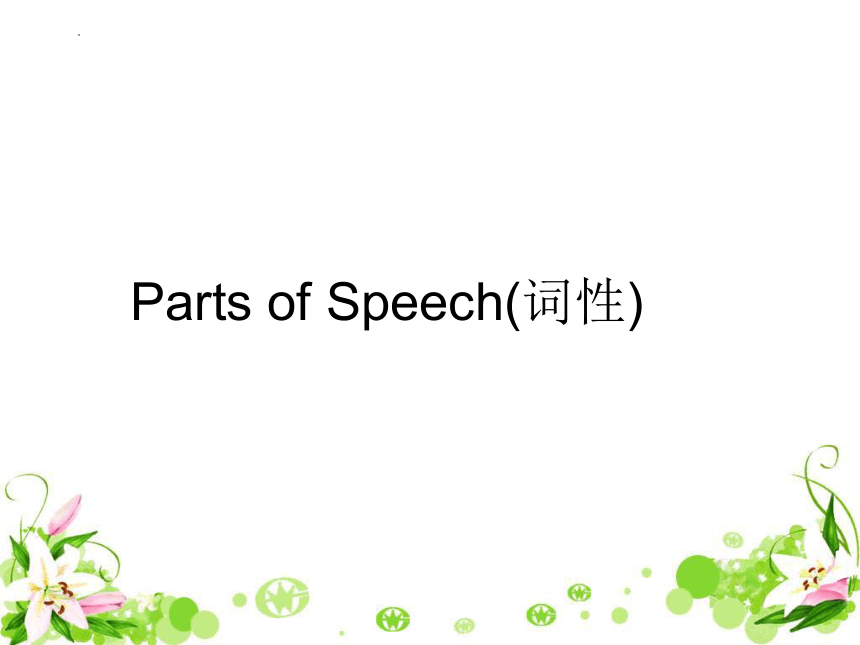
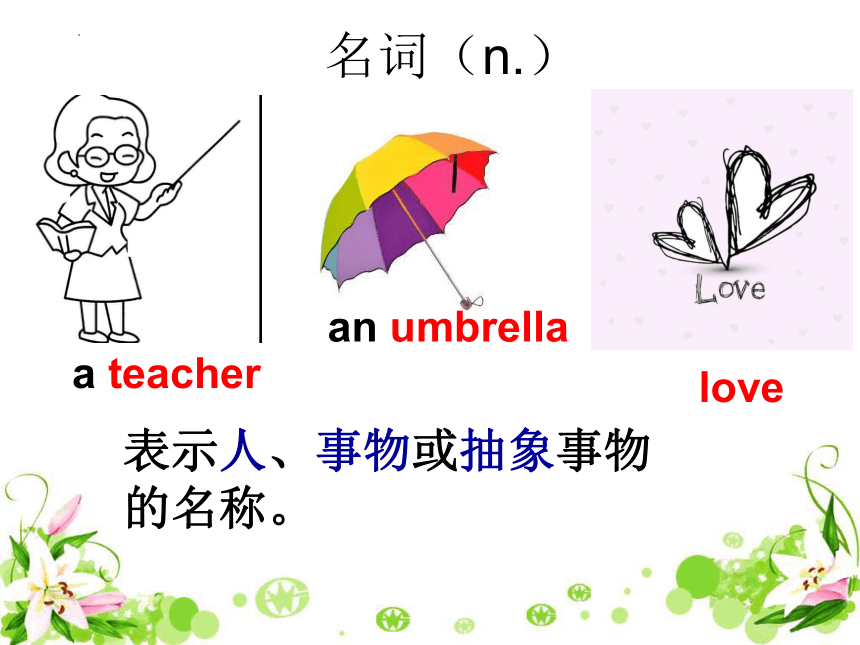
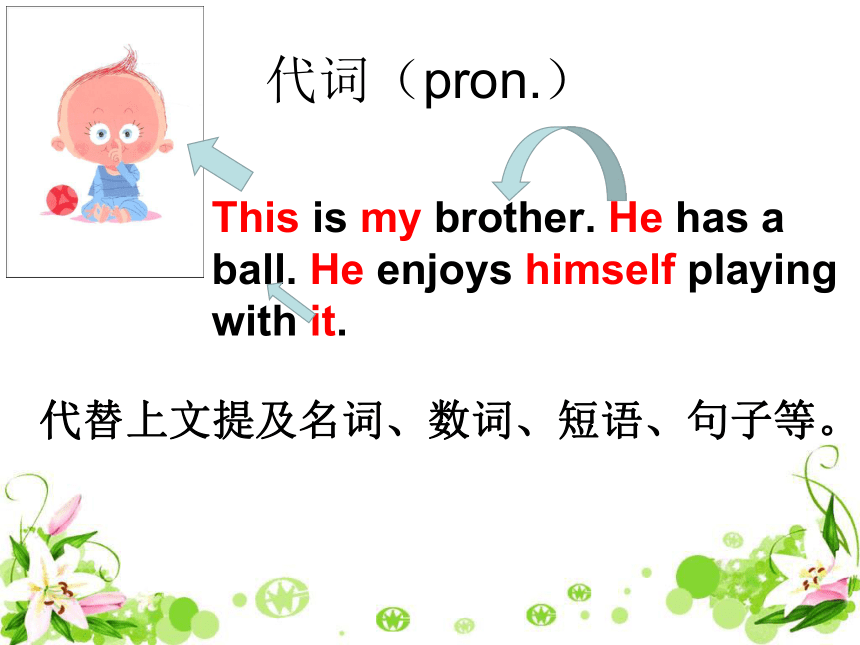
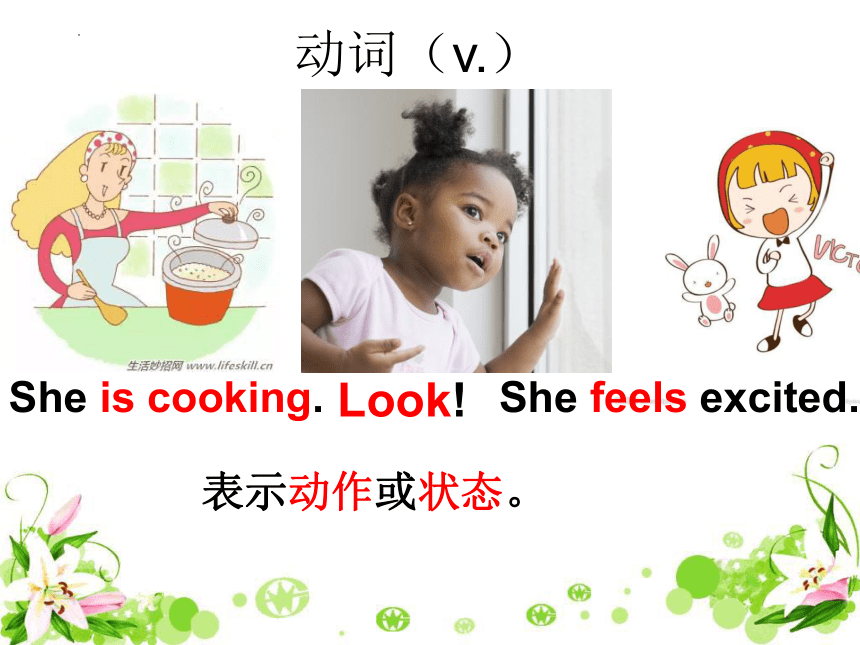
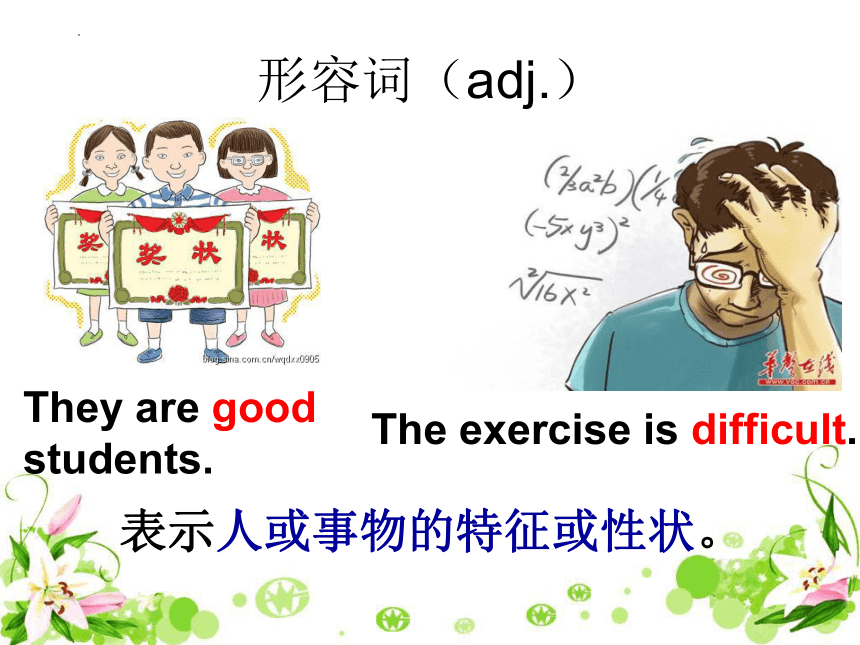
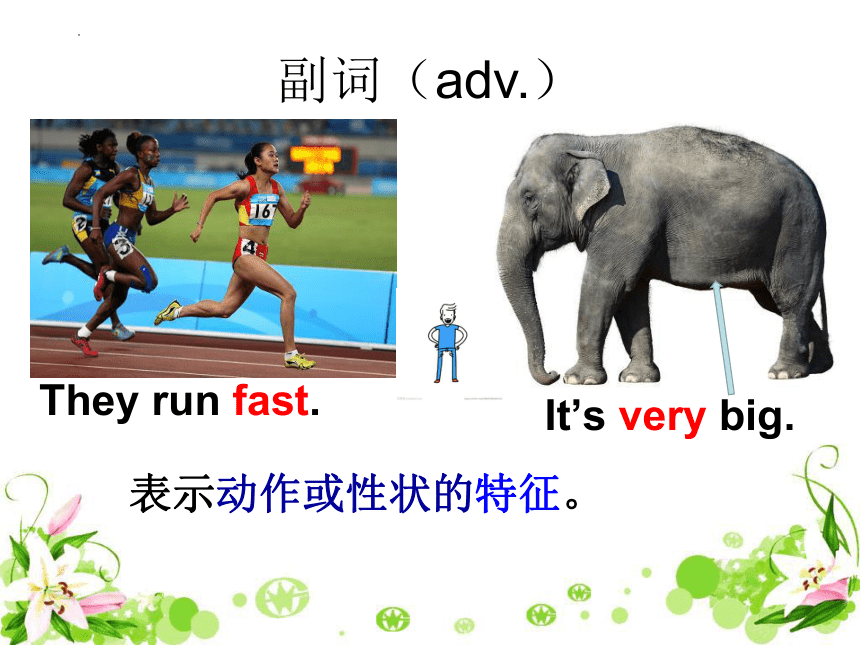

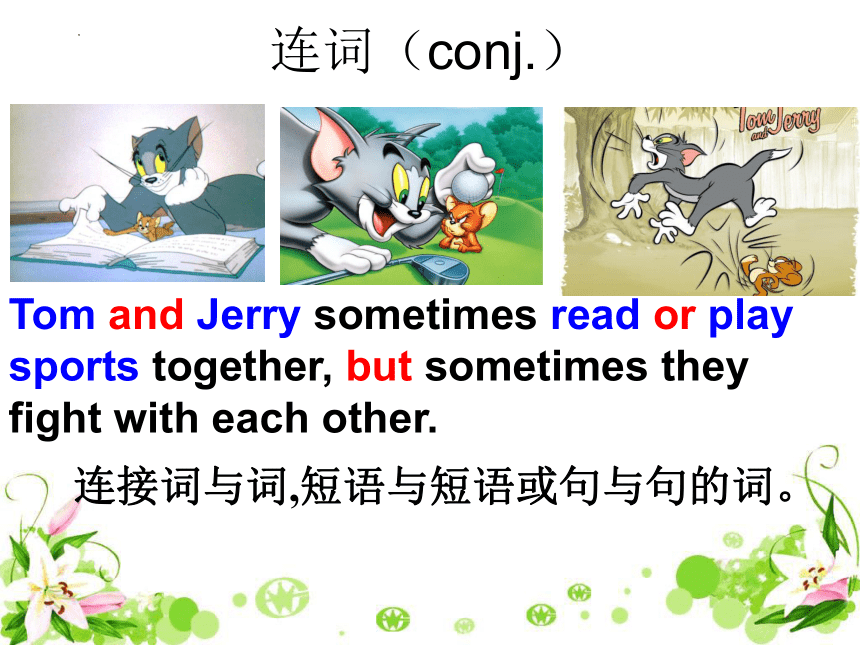

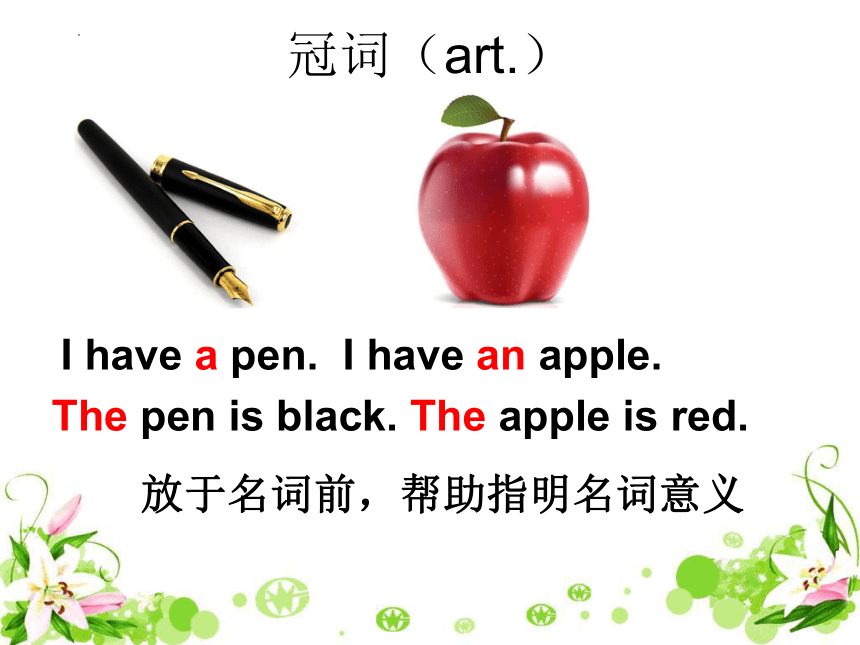
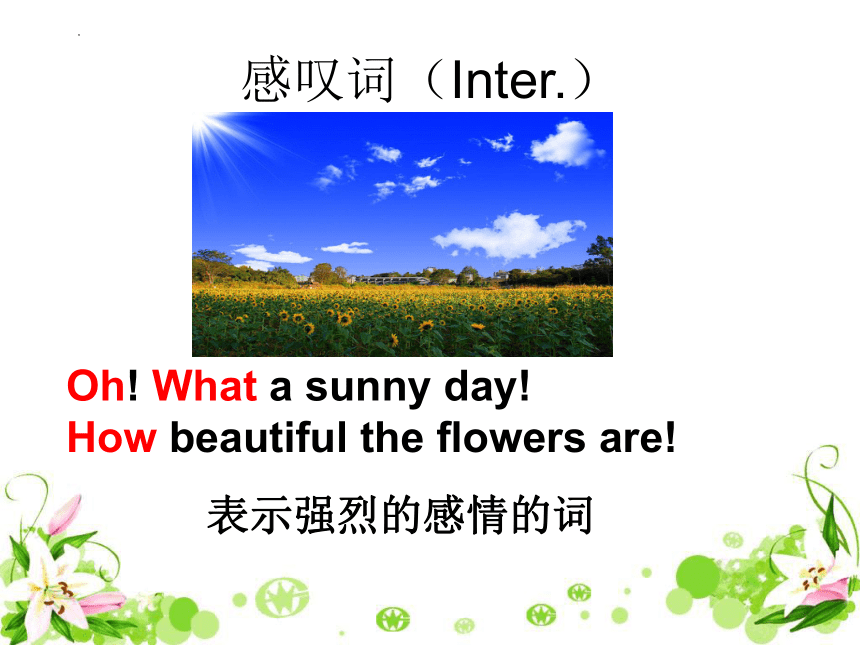
文档简介
(共34张PPT)
Learing Objectives
1. 复习各个词性的含义;
2. 掌握各个句子成分的含义及符号:主(S)谓(V)宾(O)表(P)定(Attri.)状(Adv.)补(Oc)同位语(Appo.);
3.能够判断各个单词、短语或句子在句中所作的成分;
4. 掌握简单句的构成
Parts of Speech(词性)
名词(n.)
a teacher
an umbrella
love
表示人、事物或抽象事物的名称。
代词(pron.)
This is my brother. He has a
ball. He enjoys himself playing with it.
代替上文提及名词、数词、短语、句子等。
动词(v.)
She is cooking.
Look!
表示动作或状态。
She feels excited.
形容词(adj.)
The exercise is difficult.
They are good students.
表示人或事物的特征或性状。
副词(adv.)
They run fast.
It’s very big.
表示动作或性状的特征。
介词(prep.)
The book is on the desk.
She stays at home.
表示名词、代词和其他词之间的关系。
连词(conj.)
Tom and Jerry sometimes read or play sports together, but sometimes they fight with each other.
连接词与词,短语与短语或句与句的词。
数词(num.)
two children
the first day
表示数量或顺序。
冠词(art.)
I have a pen. I have an apple.
The pen is black. The apple is red.
放于名词前,帮助指明名词意义
感叹词(Inter.)
Oh! What a sunny day!
How beautiful the flowers are!
表示强烈的感情的词
英语句子成分
Members of Stences
content
什么是句子成分
句子成分就是一个句子的各个组成部分。如果把一个句子看成是一棵树, 那么一颗树的组成部分有树干、树枝、树叶等;而一个句子的组成部分就有主语、谓语、宾语等。
英语中的句子成分主要有(7):
主语(S)、谓语(V)、宾语(O)、表语(P)、定语(Attri.)、状语(Adv.)、补语(Oc)
1.Hip-hop becomes more and more popular.
2.We often speak English in class.
3.One-third of the students in this class are girls.
4.To study in the school is a happy thing.
5.Swimming is good for our health.
6. What we want is food.
(名词)
(代词主格)
(数词)
(不定式)
(动名词)
1) 主语(subject)
动作和状态发生的主体,全句述说的对象“什么人” “什么物”,常置于_____。
句首
(句子)
注:1. There is a pencil and some pens in the box.
2. Who are you waiting for
3.在个别句型中,主语在整个句子后面,这时前面用it作形式主语。
eg: It is important for us to study English well.
4.动词原型和介词都不能做主语
1.Do exercise is good for your health.
2.The teacher with two of his students are walking into the classroom.
There be 的主语在句中(be 动词后)
疑问句中主语常在be/助/情后
I like football.
Lucy needs a pen.
Reading is a good way of study.
There is some milk in the bowl.
It takes him thirty minutes
to finish his homework.
2) 谓语(predicate verb)
说明主语做什么或怎么样。由___________担任。
2.The train leaves at 6 o’clock.
动词、动词短语
1. The boy made a cake.
4.He can play the piano.
3.She is singing in the room.
注:1. 情态动词、助动词和动词原形一起构成谓语。
常置于主语后,与主语人称一致,有多种时态。
He doesn’t like apples.
1.John with two of his friends ____ to play basketball every Sunday afternoon.
A. go B. went C. goes D.gone
2.__ up and make your bed.
A. Got B. Get C. Getting D.Gets
3.________ up early is good for your health.
A. Got B. Get C. Getting D.Gets
小试牛刀
祈使句,谓语动词用原形
3) 宾语(object)
6.They are talking about the show.
表示动作、行为的对象(接受者),常位于及物动词或介词后。由名词、代词宾格、不定式、动名词或从句充当 (同主语)。
1.The boy made a cake in the kitchen.
2.He often helps me.
3.He decide to study hard.
4.Did you finish cleaning the house
5.I think he is a good boy.
双宾语
有些及物动词可以有两个宾语: 直接宾语(Direct Object)和间接宾语(Indirect Object), 称为双宾语.直接宾语一般指物,间接宾语一般指人. 间接宾语一般放在直接宾语之前.
He gave me a book.
间接宾语
直接宾语
当间接宾语放在后面时, 并必须在其前加上介词to或for.
He gave a book to me.
常见带双宾语的动词:
1.间宾(sb)后置时前加介词for:
buy/make/cook/get/pick/find…
2.间宾(sb)后置时前加介词to:
give/take/bring/sell//tell/read/write/show…
注意: 如果直接宾语(sth.)是人称代词, 则间接宾语(sb.)必须后置, 并在其前加上介词to或for.
Here’s your report. Don’t forget to show it to your parents.
火眼金睛
1.They are working on the farm now.(主、宾)
2. She watched English programs. (谓、宾)
3. It takes me three hours to get there. (主)
5. What did you buy (主、宾)
6. Speaking doesn’t mean doing. (主、谓)
1.The little boy is a student.
2. Are you free
3.We were at home last night.
4.My hobby is to watch TV.
5.That's why I was late.
4) 表语(predicative)
说明主语是什么或怎么样,用以表述主语的
特征、状态、身份等。由名词、形容词、
数词、副词、不定式、介词短语或句子充当。常位于系动词之后。
注意区分:
He is swimming.
His favorite sport is swimming.
(谓语)
(表语)
2.What's your name
1.The little boy made a cake.
3. The boy on the bike is Lily’s brother.
5) 定语(attributive)
定语在翻译 时常译为 “……的”
4.The book my mother bought me is useful.
定语是用来说明名词品质与特征的词,______常作定语,形物代、数词、名词、介词短语、不定式或从句也可作定语。单个的词作定语一般放在被修饰词____,短语或句子作定语要_______.
形容词
前
后置
当定语修饰不定代词/副词 something、anything、someone、somewhere等时,定语要放其后作后置定语
注意:
eg: 我告诉他一些有趣的事情。
I tell him something interesting .
6) 状语(adverbial)
用以修饰adj. /v. /adv.及全句,位置灵活。一般表示动作发生的时间、地点、条件、目的、方式、程度等。常由副词、介词短语、不定式或句子充当。
1.The boy made a cake last night.
2.The boy made a cake at home.
3.The boy goes to school by bike.
注:The boy at home made a cake .
4.I really like him.
(一)副词作状语的位置:
①修饰形容词或副词时放它们前面,如very good,so early……
②放在句末修饰动词,如very much,a lot,quickly,fast,high,slowly…
③放在句中修饰动词,be/助/情后,实义动词之前,如: often,also,only,ever,still…
④有的副词在句子中位置灵活,如sometimes…
(二)多个不同状语常见4 个排序:方式
状语、目的状语、地点状语、时间状语。
1. I am very happy.
2. We often help him.
3. When I grow up , I am going to
be a teacher .
4.He came here to visit his daughter
yesterday.
5.Thank you very much/a lot.
7) 宾补(object complement)
对动词后的宾语进行补充说明。
由n. /adj. /介短 /分词 /不定式等担任。
1. They made him our monitor(班长).
2. Please keep our classroom clean.
3.My mother wants me to drink it.
8) 同位语(appositive)
在一个句子中, 一个名词/代词/短语/从句, 放在另一个名词或代词之后, 用以说明它的性质或情况, 被称为同位语。
We all got a surprise.
Liangliang, an 11-year-old boy, crosses the river every.
We had something very special— Malaysian yellow noodles.
二、 勾画句中主语
Exercises:
一、选出句中谓语
1. The girl in red doesn't like the picture .
A. doesn't like B. doesn’t C. picture D. wall
2. He got up and brushed his teeth.
A. brushed B. got up
C. his teeth D. got up and brushed
3. There will be a meeting at the library.
A. will be B. meeting
C. the library D. afternoon
4. What I want to tell you is this.
A. want B. to tell C. you D. is
三、分析下列划线部分句子成分
1.My favorite subject is English.
2.The bus stopped last night.
3.It is a good place to have fun.
4.Students in Grade Nine should be busy
this year.
5.I felt unhappy yesterday.
6.The movie made us relaxed.
Learing Objectives
1. 复习各个词性的含义;
2. 掌握各个句子成分的含义及符号:主(S)谓(V)宾(O)表(P)定(Attri.)状(Adv.)补(Oc)同位语(Appo.);
3.能够判断各个单词、短语或句子在句中所作的成分;
4. 掌握简单句的构成
Parts of Speech(词性)
名词(n.)
a teacher
an umbrella
love
表示人、事物或抽象事物的名称。
代词(pron.)
This is my brother. He has a
ball. He enjoys himself playing with it.
代替上文提及名词、数词、短语、句子等。
动词(v.)
She is cooking.
Look!
表示动作或状态。
She feels excited.
形容词(adj.)
The exercise is difficult.
They are good students.
表示人或事物的特征或性状。
副词(adv.)
They run fast.
It’s very big.
表示动作或性状的特征。
介词(prep.)
The book is on the desk.
She stays at home.
表示名词、代词和其他词之间的关系。
连词(conj.)
Tom and Jerry sometimes read or play sports together, but sometimes they fight with each other.
连接词与词,短语与短语或句与句的词。
数词(num.)
two children
the first day
表示数量或顺序。
冠词(art.)
I have a pen. I have an apple.
The pen is black. The apple is red.
放于名词前,帮助指明名词意义
感叹词(Inter.)
Oh! What a sunny day!
How beautiful the flowers are!
表示强烈的感情的词
英语句子成分
Members of Stences
content
什么是句子成分
句子成分就是一个句子的各个组成部分。如果把一个句子看成是一棵树, 那么一颗树的组成部分有树干、树枝、树叶等;而一个句子的组成部分就有主语、谓语、宾语等。
英语中的句子成分主要有(7):
主语(S)、谓语(V)、宾语(O)、表语(P)、定语(Attri.)、状语(Adv.)、补语(Oc)
1.Hip-hop becomes more and more popular.
2.We often speak English in class.
3.One-third of the students in this class are girls.
4.To study in the school is a happy thing.
5.Swimming is good for our health.
6. What we want is food.
(名词)
(代词主格)
(数词)
(不定式)
(动名词)
1) 主语(subject)
动作和状态发生的主体,全句述说的对象“什么人” “什么物”,常置于_____。
句首
(句子)
注:1. There is a pencil and some pens in the box.
2. Who are you waiting for
3.在个别句型中,主语在整个句子后面,这时前面用it作形式主语。
eg: It is important for us to study English well.
4.动词原型和介词都不能做主语
1.Do exercise is good for your health.
2.The teacher with two of his students are walking into the classroom.
There be 的主语在句中(be 动词后)
疑问句中主语常在be/助/情后
I like football.
Lucy needs a pen.
Reading is a good way of study.
There is some milk in the bowl.
It takes him thirty minutes
to finish his homework.
2) 谓语(predicate verb)
说明主语做什么或怎么样。由___________担任。
2.The train leaves at 6 o’clock.
动词、动词短语
1. The boy made a cake.
4.He can play the piano.
3.She is singing in the room.
注:1. 情态动词、助动词和动词原形一起构成谓语。
常置于主语后,与主语人称一致,有多种时态。
He doesn’t like apples.
1.John with two of his friends ____ to play basketball every Sunday afternoon.
A. go B. went C. goes D.gone
2.__ up and make your bed.
A. Got B. Get C. Getting D.Gets
3.________ up early is good for your health.
A. Got B. Get C. Getting D.Gets
小试牛刀
祈使句,谓语动词用原形
3) 宾语(object)
6.They are talking about the show.
表示动作、行为的对象(接受者),常位于及物动词或介词后。由名词、代词宾格、不定式、动名词或从句充当 (同主语)。
1.The boy made a cake in the kitchen.
2.He often helps me.
3.He decide to study hard.
4.Did you finish cleaning the house
5.I think he is a good boy.
双宾语
有些及物动词可以有两个宾语: 直接宾语(Direct Object)和间接宾语(Indirect Object), 称为双宾语.直接宾语一般指物,间接宾语一般指人. 间接宾语一般放在直接宾语之前.
He gave me a book.
间接宾语
直接宾语
当间接宾语放在后面时, 并必须在其前加上介词to或for.
He gave a book to me.
常见带双宾语的动词:
1.间宾(sb)后置时前加介词for:
buy/make/cook/get/pick/find…
2.间宾(sb)后置时前加介词to:
give/take/bring/sell//tell/read/write/show…
注意: 如果直接宾语(sth.)是人称代词, 则间接宾语(sb.)必须后置, 并在其前加上介词to或for.
Here’s your report. Don’t forget to show it to your parents.
火眼金睛
1.They are working on the farm now.(主、宾)
2. She watched English programs. (谓、宾)
3. It takes me three hours to get there. (主)
5. What did you buy (主、宾)
6. Speaking doesn’t mean doing. (主、谓)
1.The little boy is a student.
2. Are you free
3.We were at home last night.
4.My hobby is to watch TV.
5.That's why I was late.
4) 表语(predicative)
说明主语是什么或怎么样,用以表述主语的
特征、状态、身份等。由名词、形容词、
数词、副词、不定式、介词短语或句子充当。常位于系动词之后。
注意区分:
He is swimming.
His favorite sport is swimming.
(谓语)
(表语)
2.What's your name
1.The little boy made a cake.
3. The boy on the bike is Lily’s brother.
5) 定语(attributive)
定语在翻译 时常译为 “……的”
4.The book my mother bought me is useful.
定语是用来说明名词品质与特征的词,______常作定语,形物代、数词、名词、介词短语、不定式或从句也可作定语。单个的词作定语一般放在被修饰词____,短语或句子作定语要_______.
形容词
前
后置
当定语修饰不定代词/副词 something、anything、someone、somewhere等时,定语要放其后作后置定语
注意:
eg: 我告诉他一些有趣的事情。
I tell him something interesting .
6) 状语(adverbial)
用以修饰adj. /v. /adv.及全句,位置灵活。一般表示动作发生的时间、地点、条件、目的、方式、程度等。常由副词、介词短语、不定式或句子充当。
1.The boy made a cake last night.
2.The boy made a cake at home.
3.The boy goes to school by bike.
注:The boy at home made a cake .
4.I really like him.
(一)副词作状语的位置:
①修饰形容词或副词时放它们前面,如very good,so early……
②放在句末修饰动词,如very much,a lot,quickly,fast,high,slowly…
③放在句中修饰动词,be/助/情后,实义动词之前,如: often,also,only,ever,still…
④有的副词在句子中位置灵活,如sometimes…
(二)多个不同状语常见4 个排序:方式
状语、目的状语、地点状语、时间状语。
1. I am very happy.
2. We often help him.
3. When I grow up , I am going to
be a teacher .
4.He came here to visit his daughter
yesterday.
5.Thank you very much/a lot.
7) 宾补(object complement)
对动词后的宾语进行补充说明。
由n. /adj. /介短 /分词 /不定式等担任。
1. They made him our monitor(班长).
2. Please keep our classroom clean.
3.My mother wants me to drink it.
8) 同位语(appositive)
在一个句子中, 一个名词/代词/短语/从句, 放在另一个名词或代词之后, 用以说明它的性质或情况, 被称为同位语。
We all got a surprise.
Liangliang, an 11-year-old boy, crosses the river every.
We had something very special— Malaysian yellow noodles.
二、 勾画句中主语
Exercises:
一、选出句中谓语
1. The girl in red doesn't like the picture .
A. doesn't like B. doesn’t C. picture D. wall
2. He got up and brushed his teeth.
A. brushed B. got up
C. his teeth D. got up and brushed
3. There will be a meeting at the library.
A. will be B. meeting
C. the library D. afternoon
4. What I want to tell you is this.
A. want B. to tell C. you D. is
三、分析下列划线部分句子成分
1.My favorite subject is English.
2.The bus stopped last night.
3.It is a good place to have fun.
4.Students in Grade Nine should be busy
this year.
5.I felt unhappy yesterday.
6.The movie made us relaxed.
同课章节目录
- 词法
- 名词
- 动词和动词短语
- 动词语态
- 动词时态
- 助动词和情态动词
- 非谓语动词
- 冠词
- 代词
- 数词和量词
- 形容词副词及其比较等级
- 介词和介词短语
- 连词和感叹词
- 构词法
- 相似、相近词比较
- 句法
- 陈述句
- 一般疑问句和否定疑问句
- 特殊疑问句及选择疑问句
- 反意疑问句
- 存在句(There be句型)
- 宾语从句
- 定语从句
- 状语从句
- 主谓一致问题
- 简单句
- 并列句
- 复合句
- 主谓一致
- 主、表语从句
- 名词性从句
- 直接引语和间接引语
- 虚拟语气
- 感叹句
- 强调句
- 倒装句
- 祈使句
- 句子的成分
- 句子的分类
- 题型专区
- 单项选择部分
- 易错题
- 完形填空
- 阅读理解
- 词汇练习
- 听说训练
- 句型转换
- 补全对话
- 短文改错
- 翻译
- 书面表达
- 任务型阅读
- 语法填空
- 其他资料
